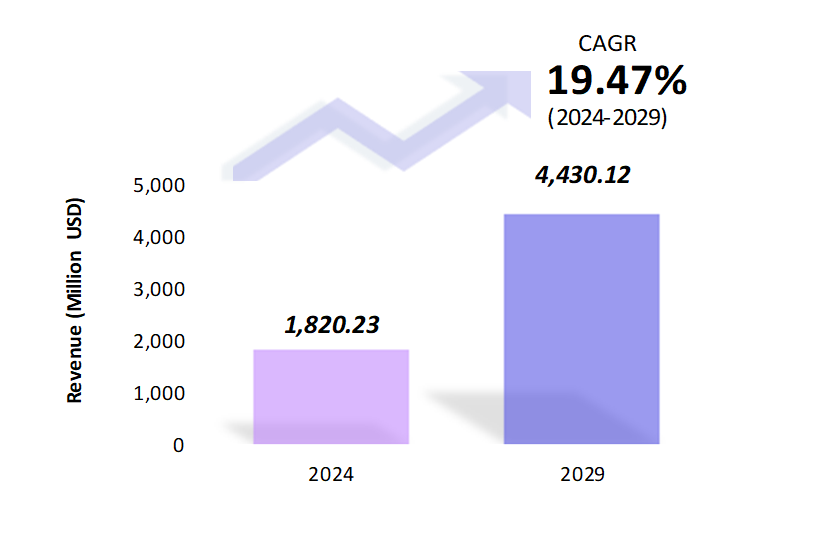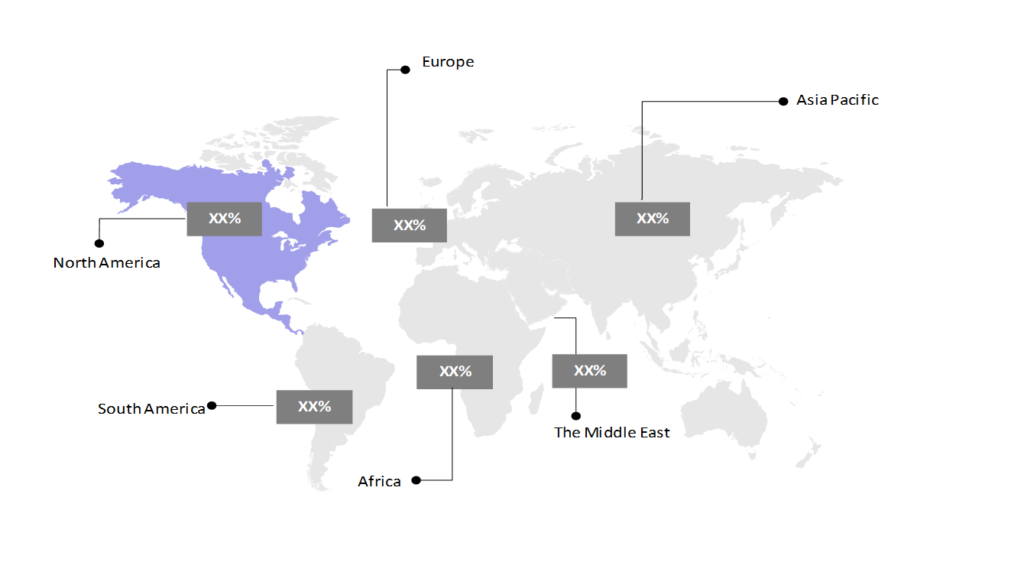Video Telematics Market Analysis: Growth, Size, Share & Future Trends (2024-2029)
The market report offers a detailed analysis segmented by Type (Integrated Systems, Standalone Systems); by Application (Buses, Heavy Trucks, LCVs, Passenger Cars); by Geography (North America, South America, Asia Pacific, Europe, The Middle East, Africa).
Outlook

- The video telematics market is estimated to be at USD 1,820.23 Mn in 2024 and is anticipated to reach USD 4,430.12 Mn in 2029.
- The video telematics market is registering a CAGR of 19.47% during the forecast period 2024-2029.
- The video telematics market is evolving rapidly as businesses, particularly in the logistics, transportation, and fleet management sectors, increasingly adopt solutions that integrate real-time video monitoring with telematics data. Video telematics systems, which include dashcams and onboard cameras, allow for enhanced safety, better driver behavior analysis, and improved fleet efficiency. Growing concerns over road safety, the need for driver accountability, and the push for more streamlined fleet operations are driving the market forward.
Request a free sample.
Ecosystem

- The participants in the global video telematics industry are always developing their strategies to preserve a competitive advantage.
- Leading companies are focusing on integrating advanced technologies such as artificial intelligence (AI), machine learning (ML), and IoT (Internet of Things) to enhance the capabilities of their telematics systems.
- Several important entities in the video telematics market include Sensata Technologies, Inc; Verizon Communications Inc.; Omnitracs, LLC; VisionTrack Ltd.; Nauto, Inc.; and others.
Ask for customization.
Findings
| Attributes | Values |
|---|---|
| Historical Period | 2018-2022 |
| Base Year | 2023 |
| Forecast Period | 2024-2029 |
| Market Size (2024) | USD 1,820.23 Mn |
| Market Size (2029) | USD 4,430.12 Mn |
| Growth Rate | 19.47% CAGR from 2024 to 2029 |
| Key Segments | Type (Integrated Systems, Standalone Systems); Application (Buses, Heavy Trucks, LCVs, Passenger Cars); Geography (North America, South America, Asia Pacific, Europe, The Middle East, Africa) |
| Key Vendors | Sensata Technologies, Inc; Verizon Communications Inc.; Omnitracs, LLC; VisionTrack Ltd.; Nauto, Inc. |
| Key Countries | The US; Canada; Mexico; Brazil; Argentina; Colombia; Chile; China; India; Japan; South Korea; The UK; Germany; Italy; France; Spain; Turkey; UAE; Saudi Arabia; Egypt; South Africa |
| Largest Market | North America |
Get a free quote.
Trends
- Cloud-Based Data Solutions: The shift towards cloud-based platforms allows for easier storage, real-time access, and analysis of telematics data. Cloud infrastructure is enhancing collaboration between fleet managers and drivers by offering real-time alerts and video evidence, which can be accessed remotely.
- Driver Behavior Recognition: Video telematics is now focusing on detailed driver behavior analysis. Systems equipped with facial recognition and real-time feedback are helping fleet operators reduce risky behaviors such as distracted driving. For instance, Lytx’s Driver Safety Program uses video to help drivers improve safety practices through behavioral coaching.
- Integration with Advanced Driver Assistance Systems (ADAS): Video telematics systems are increasingly being integrated with ADAS technologies, including collision warnings, blind spot detection, and automatic emergency braking systems. By combining video data with ADAS features, fleet operators can proactively prevent accidents and detect potential hazards earlier, which creates a safer and more efficient driving environment.
Speak to analyst.
Catalysts
- Growing Focus on Fleet Safety: Rising incidents of road accidents and increasing demand for safer fleet operations have prompted companies to adopt video telematics solutions. For instance, UPS and FedEx have deployed video telematics to enhance driver accountability and reduce accidents.
- Regulatory Compliance: Governments are introducing stringent regulations regarding driver safety and vehicle management. Video telematics helps fleet operators comply with these regulations by providing proof of compliance, such as evidence of driver behavior and safety protocols.
- Insurance Benefits: Many insurance companies are offering reduced premiums for fleets that use video telematics systems, as they help mitigate risks and provide evidence in the event of claims. Progressive Insurance company has partnered with telematics providers to offer discounted rates based on driving behavior data.
Inquire before buying.
Restraints
- High Initial Investment Costs: The implementation of video telematics systems can be financially challenging for small and medium-sized businesses, particularly those managing large fleets. The initial expenses include hardware like cameras and sensors, recurring software subscription fees, and the cost of data storage for video footage. This financial barrier is amplified when scaling the system across multiple vehicles, which makes it difficult for smaller operators to adopt these advanced solutions.
- Data Privacy and Security Concerns: Video telematics systems capture real-time video footage and sensitive data, raising significant concerns about privacy and data security. Companies must ensure robust cybersecurity measures to protect this data from cyberattacks and unauthorized access. Additionally, compliance with evolving data protection regulations, such as General Data Protection Act GDPR in Europe and Central Consumer Protection Authority CCPA in California, adds complexity and requires continuous monitoring and updates to privacy protocols.
- Connectivity Issues in Remote Areas: Reliable network connectivity is critical for the successful operation of video telematics systems, especially for transmitting real-time data and footage. In rural or remote locations where 4G or 5G networks may be limited or unavailable, system performance can be significantly impaired. This can hinder the timely transmission of crucial data, which reduces the overall effectiveness of the telematics solution in improving fleet management and safety.
Personalize this research.
Hotspot

Explore purchase options.
Table of Contents
| 1. Introduction 1.1. Research Methodology 1.2. Scope of the Study 2. Market Overview / Executive Summary 2.1. Global Video Telematics Market (2018 – 2022) 2.2. Global Video Telematics Market (2023 – 2029) 3. Market Segmentation 3.1. Global Video Telematics Market by Type 3.1.1. Integrated Systems 3.1.2. Standalone Systems 3.2. Global Video Telematics Market by Application 3.2.1. Buses 3.2.2. Heavy Trucks 3.2.3. LCVs 3.2.4. Passenger Cars 4. Regional Segmentation 4.1. North America 4.1.1. The US 4.1.2. Canada 4.1.3. Mexico 4.2. South America 4.2.1. Brazil 4.2.2. Argentina 4.2.3. Colombia 4.2.4. Chile 4.2.5. Rest of South America 4.3. Asia Pacific 4.3.1. China 4.3.2. India 4.3.3. Japan 4.3.4. South Korea 4.3.5. Rest of Asia Pacific 4.4. Europe 4.4.1. The UK 4.4.2. Germany 4.4.3. Italy 4.4.4. France 4.4.5. Spain 4.4.6. Rest of Europe 4.5. The Middle East 4.5.1. Turkey 4.5.2. UAE 4.5.3. Saudi Arabia 4.5.4. Rest of the Middle East 4.6. Africa 4.6.1. Egypt 4.6.2. South Africa 4.6.3. Rest of Africa 5. Value Chain Analysis of the Global Video Telematics Market 6. Porter Five Forces Analysis 6.1. Threats of New Entrants 6.2. Threats of Substitutes 6.3. Bargaining Power of Buyers 6.4. Bargaining Power of Suppliers 6.5. Competition in the Industry 7. Trends, Drivers and Challenges Analysis 7.1. Market Trends 7.1.1. Market Trend 1 7.1.2. Market Trend 2 7.1.3. Market Trend 3 7.2. Market Drivers 7.2.1. Market Driver 1 7.2.2. Market Driver 2 7.2.3. Market Driver 3 7.3. Market Challenges 7.3.1. Market Challenge 1 7.3.2. Market Challenge 2 7.3.3. Market Challenge 3 8. Opportunities Analysis 8.1. Market Opportunity 1 8.2. Market Opportunity 2 8.3. Market Opportunity 3 9. Competitive Landscape 9.1. Sensata Technologies, Inc 9.2. Verizon Communications Inc. 9.3. Omnitracs, LLC 9.4. VisionTrack Ltd. 9.5. Nauto, Inc. 9.6. Company 6 9.7. Company 7 9.8. Company 8 9.9. Company 9 9.10. Company 10 |
Know the research methodology.
Video Telematics Market – FAQs
1. What is the current size of the video telematics market?
Ans. In 2024, the video telematics market size is USD 1,820.23 Mn.
2. Who are the major vendors in the video telematics market?
Ans. The major vendors in the video telematics market are Sensata Technologies, Inc; Verizon Communications Inc.; Omnitracs, LLC; VisionTrack Ltd.; Nauto, Inc.
3. Which segments are covered under the video telematics market segments analysis?
Ans. The video telematics market report offers in-depth insights into Type, Application, and Geography.
